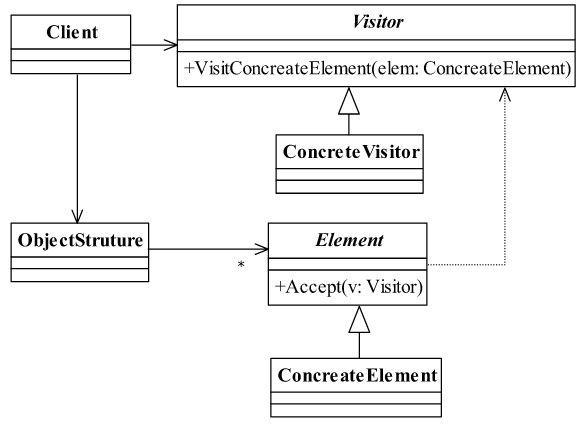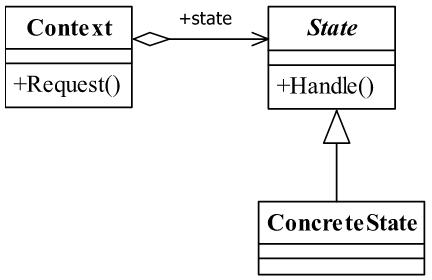访问者模式 访问者模式是一种集中规整模式,适合用于重构项目时(重构时需求已经清晰,原有的功能点也明确)
定义 封装一些用于某种数据结构中的各个元素的操作,可以在不改变数据结构的前提下定义作用于这些元素的新操作。
角色 Visitor 抽象访问者 抽象类或者接口,声明访问者可以访问哪些元素,具体到程序中就是visit方法的参数定义哪些对象是可以被访问的。
1 2 3 4 public interface IVisitor public void visit (ConcreteElement1 el1) public void visit (ConcreteElement2 el2) }
ConcreteVisitor 具体访问者 影响访问者访问到一个类后该做什么事情。
1 2 3 4 5 6 7 8 public class Visitor implements IVisitor public void visit (ConcreteElement1 el1) el1.doSomething(); } public void visit (ConcreteElement2 el2) el2.doSomething(); } }
Element 抽象元素 接口或者抽象类,声明接受哪一类访问者访问。
1 2 3 4 5 6 public abstract class Element public abstract void doSomething () public abstract void accept (IVisitor visitor) }
ConcreteElement 具体元素 实现accept方法, 通常是 visitor.visit(this)模式。
1 2 3 4 5 6 7 8 9 10 11 12 public class ConcreteElement1 extends Element public void doSomething () public void accept (IVisitor visitor) visitor.visit(this ); } } public class ConcreteElement2 extends Element public void doSomething () public void accept (IVisitor visitor) visitor.visit(this ); } }
ObjectStructure结构对象 元素生产者,一般容纳在多个不同类、不同接口的容器,如List/Set/Map。
1 2 3 4 5 public class ObjectStructure public static Element createElement () return new Random().nextInt(10 ) > 5 ? new ConcreteElement1() : new ConcreteElement2(); } }
使用 1 2 3 for (int i = 0 ; i < 10 ; i++){ ObjectStructure.createElement().accept(new Visitor()); }
优点
缺点
违背了迪米特法则,Element具体的细节需要公布给Visitor
具体元素变更比较困难,元素增加/减少字段Visitor都需要修改
违背了依赖倒置原则,访问者依赖的是具体的元素,而不是抽象元素。
使用场景 当一个对象结构包含很多类对象,它们有不同的接口,需要对这些对象实施一些依赖于其具体类的操作。
双分派 1 2 3 4 5 6 7 8 9 10 11 12 13 14 15 16 17 18 19 20 public abstract class AbsActor public void act (Role role) System.out.println("Actor can act any role." ); } public void act (KungFuRole role) System.out.println("Actor can act Kungfu Role." ); } } public class YongActor extends AbsActor public void act (KungFuRole role) System.out.println("Yong Man Lov Act KungFu Role." ); } } public class OldActor extends AbsActor public void act (KungFuRole role) System.out.println("Old Man Can Not Act KungFu Role." ) } }
1 2 3 4 5 6 7 8 9 10 11 12 13 public interface Role public void accept (AbsActor actor) } public class KungFuRole extends Role public void accept (AbsActor actor) actor.act(this ); } } public class IdiotRole extends Role public void accept (AbsActor actor) actor.act(this ); } }
1 2 3 4 AbsActor actor = new OldActor(); Role role = new KungFuRole(); actor.act(role); actor.act(new KungFuRole());
1 2 3 4 AbsActor actor = new OldActor(); Role role = new KungFuRole(); role.accept(actor);

